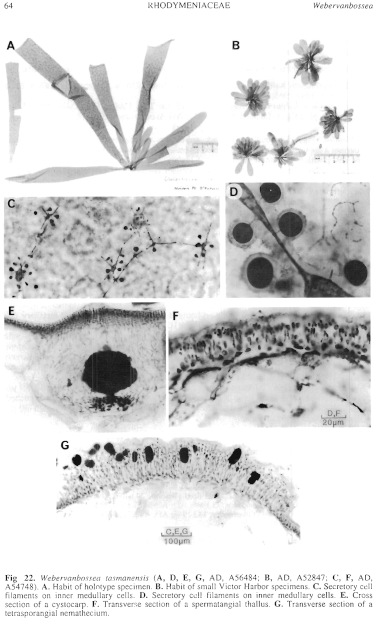|
|
|
|
|
|||||||||||
|
Electronic Flora of South Australia Species Fact Sheet
Phylum Rhodophyta – Class Florideophyceae – Order Rhodymeniales – Family Rhodymeniaceae
Synonyms
Bindera levringii Lindauer, ined.
Halosaccion levringii Chapman & Dromgoole 1970: 126, fig. 42, pl. 41, left (nom. nud.).
Thallus (Fig. 22A, B) medium red-brown, fading to grey-red, with one to several elongate-ovoid to clavate or fusiform, terete to compressed, mostly simple (some with small ovoid proliferations) bladders from the holdfast, (0.5–) 4–10 (–30) cm long and (2–) 3–6 (–35) mm in diameter, with rounded apices and tapering below gradually or abruptly to a short, slender, stipe; contents mucilaginous. Holdfast discoid, 1–3 mm across; epiphytic on larger algae and seagrasses, or epilithic. Structure multiaxial, developing a cortex with short, simple or branched anticlinal filaments (1–) 2–3 cells and 15–30 (–40) µm long, outer cells ovoid and 3–5 µm in diameter, borne on inner, periclinally ovoid, cells 6–10 µm in diameter, with a medulla 1 (–2) cells thick, cells fairly regularly placed in a single row, the larger inner cells ovoid, 90–200 (–300) µm in diameter, with numerous secondary pit-connections. Outer cortical cells sometimes forming rosettes in surface view, soon forming a continuous layer. Secretory cells (Fig. 22C, D) borne on cells cut off inwards from the large medullary cells, with long, slender arms which often link with arms of adjacent cells forming a lax reticulum; secretory cells on both the cells and their arms, ovoid, 12–22 (–30) µm in diameter. Hairs common. Rhodoplasts discoid to elongate, becoming ribbon like in medullary cells.
Reproduction: Gametangial thalli dioecious. Carpogonial branches unknown. Carposporophytes (Fig. 22E) ovoid, compact, (200–) 300–700 µm broad, with a basal, often branched, fusion cell bearing one to a few closely adjacent lobes of ovoid carposporangia 15–30 µm in diameter. Basal nutritive tissue with erect, slender, and relatively persistent filaments around the carposporophyte, and small-celled filaments around the ostiole. Cystocarps (Fig. 22E) scattered, 500–800 µm across, slightly swelling the surface but more so inwardly, pericarp 60–100 µm thick, ostiolate. Spermatangia (Fig. 22F) cut off from surface cortical cells via initials, ovoid, 1.5–2.5 µm in diameter.
Tetrasporangia (Fig. 22G) in discrete, scattered, ovate nemathecia 1–1.5 mm across, with extended cortical filaments 6–9 cells and 130–270 µm long, branched from most cells, mid cells 4–6 µm in diameter and L/D 4–6, outermost cells 3–5 µm in diameter and L/D 1–2. Tetrasporangia pit-connected basally to mid cells, ovoid, 30–85 µm long and 22–50 µm in diameter, decussately or cruciately divided.
Type from Ninepin Point, D'Entrecasteaux Ch., Tas., 1–2 m deep (Thomas & Womersley, 1.xi.1982); holotype in AD, A56484 - isotypes in "Marine Algae of southern Australia" No. 381.
Selected specimens: 4 km S of Redcliff Point, Spencer Gulf, S. Aust., on Posidonia sinuosa, 10 m deep (Johnson, 27.vi.1978; AD, A50514); Tiparra Reef, S. Aust., on Amphibolis antarctica, 5 m deep (Shepherd, 13.vii.1971; AD, A39250); Young Rocks, S of Kangaroo I., S. Aust., 16–30 m deep, on stalked sponge (Branden, 18.vi.1991; AD, A61454). Victor Harbor, S. Aust., on Amphibolis antarctica, 6 m deep (Clarke, 30.xii.1981; AD, A52847). Port MacDonnell, S. Aust., on Caulerpa papillosa, drift (Kraft 7769 & Herrington, 31.x.1988; MELU). Stanley, N Tas., drift on Heterozostera (Womersley, 17.x.1982; AD, A56228). Bluestone Bay, Freycinet Pen., Tas., 6–13 m deep on Galaxaura marginata (Ellis & Solander) Lamouroux (Brown, McGeary & Womersley, 6.xi.1982; AD, A54748). Lady Bay, Southport, Tas., 5 m deep (Brown & Womersley, 28.x.1982; AD, A56540). Ninepin Point., Tas., 8–11 m deep, on rock (Kraft 9157 & Sanderson, 22.xii.1992; MELU).
Distribution: Redcliff Point and Tiparra Reef to Port MacDonnell, S. Aust., and N and SE Tasmania.
New Zealand (southern S. Island, Stewart I.).
Taxonomic notes: New Zealand: Ringa Ringa, Stewart I., drift (Womersley, 4.i.1966; AD, A29837). Halfmoon Bay, Stewart I., 4 m deep (Hay, 26.i.1983; AD, A54341).
This species has been known in New Zealand as Bindera levringii Lindauer (Alg. Nova-Zel. Exsicc. 265) and Halosaccion levringii Chapman & Dromgoole; the first name had no description and the latter is invalid since there was no latin description. Since the species occurs on both sides of the Tasman Sea, it is here named Webervanbossea tasmanensis.
W. tasmanensis varies greatly in size, with the largest plants from the cooler waters of SE Tasmania and Stewart I. It becomes fertile when very small (about 5 mm long, as in AD, A61454) but the small and large plants appear identical in structure and reproduction.
W. tasmanensis is similar in structure to the previous two species of the genus, but has a simple, unconstricted, saccate thallus. In this respect it is similar in form to Gloiosaccion brownii, but the tetrasporangia are borne laterally rather than transformed from intercalary cortical cells, and the gland cells on branched cells internal to the medulla are similar to those of the other species of Webervanbossea.
References:
CHAPMAN, V.J. & DROMGOOLE, F.I. (1970). The marine algae of New Zealand, Part III: Rhodophyceae. Issue 2: Florideophycidae: Rhodyméniales, pp. 115–154, Plates 39–50. (Cramer: Germany.)
The Marine Benthic Flora of Southern Australia Part IIIB complete list of references.
Publication:
Womersley, H.B.S. (28 June, 1996)
The Marine Benthic Flora of Southern Australia
Rhodophyta. Part IIIB. Gracilarialse, Rhodymeniales, Corallinales and Bonnemaisoniales
Reproduced with permission from The Marine Benthic Flora of Southern Australia Part IIIB 1996, by H.B.S. Womersley. Australian Biological Resources Study, Canberra. Copyright Commonwealth of Australia.
Illustration in Womersley Part IIIA, 1996: FIG. 22.

Figure 22 enlarge
Fig. 22. Webervanbossea tasmanensis (A, D, E, G, AD, A56484; B, AD, A52847; C, F, AD, A54748). A. Habit of holotype specimen. B. Habit of small Victor Harbor specimens. C. Secretory cell filaments on inner medullary cells. D. Secretory cell filaments on inner medullary cells. E. Cross section of a cystocarp. F. Transverse section of a spermatangial thallus. G. Transverse section of a tetrasporangial nemathecium.

|
Email Contact: State Herbarium of South Australia |

|